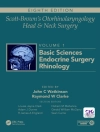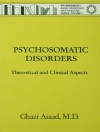This well-illustrated textbook is the first comprehensive and authoritative source of information on minimally invasive lateral access spine surgery. It covers all aspects of the subject, including patient selection, approach and monitoring techniques, soft tissue management, application in a variety of pathologies, technical nuances, and the prevention and management of complications. In addition, current controversies in the field are discussed and the biomechanics of lateral spinal reconstruction, the physiologic benefits, and cost implications are explained. As use of the lateral approach in spinal surgery has become more popular, so its diversity and complexity have increased. Nevertheless, publications devoted entirely to the technique are lacking, and
Lateral Access Minimally Invasive Spine Surgery is designed to fill this vacuum. Written by the world’s experts on the topic, it will be an excellent resource for both beginning and experienced surgeons.
قائمة المحتويات
Introduction: History and rationale for the minimally invasive lateral approach.- Biomechanics of lateral spinal reconstruction.- Physiologic benefits and the impact on the patient.- Costs and economic implications.- Workup and diagnostic injections.- Implants and lateral cages.
Approach and localization : Patient selection.- Positioning and safety.- Intraoperative electrophysiologic monitoring.- Motor based monitoring.- Flouroscopic techniques.- Frameless navigation.- Techniques for avoiding psoas muscle and lumbosacral plexus injury.
Soft tissue management : Single vs. dual incisions.- Retractor technology.- Transpsoas vs. Anterior To Psoas (ATP).- Thoracic MIS retro pleural access.- Psoas muscle management.
Pathologies : Degenerative disc disease.- Spondylolisthesis.- Scoliosis.- Sagittal deformities.- Neoplasia.- Trauma.- Infection.- Adjacent level disease & Proximal junctional kyphosis.-
Technical Nuances : Lateral fixation.- Posterior fixation options.- ALL sectioning.- Surgery at the L5-S1 level.- Osteobiologics.
Managing and preventing complications : Vascular.- Hollow viscus.- Hernia.- Pseudarthrosis.
Controversies : Selective apical fusions.- Short segment vs. Long segment fusions.- Approaching a deformity from the concavity vs. convexity.
عن المؤلف
Michael Y. Wang, MD, FACS, is Professor with Tenure in the Departments of Neurosurgery and Physical Medicine & Rehabilitation, University of Miami Miller School of Medicine, Miami, Florida, USA. Dr. Wang’s previous positions include Spine Program Director, Department of Neurosurgery, University of Southern California, Los Angeles, and Chief, Spine Surgery Program, Rancho Los Amigos Rehabilitation Center, Los Angeles. He became a Diplomate of the American Board of Neurological Surgeons in 2006 and a Fellow of the American College of Surgeons in 2007. Dr. Wang has held a variety of national leadership positions, including as a Member of the AANS/CNS Joint Spine Section Executive Committee (since 2006) and Scientific Program Chair of the AANS/CNS Joint Spine Section (2013–2014). He is a member of several journal editorial review boards, including Journal of Neurosurgery: Spine, Acta Neurochirurgica, and Journal of Spinal Disorders and Techniques. Dr. Wang isthe lead or co-author of 107 peer-reviewed journal publications. He has co-edited several previous books, including Minimally Invasive Spinal Deformity Surgery: An Evolution of Modern Techniques (Springer, Vienna, 2013).
Andrew A. Sama, MD, graduated from the University of Miami, School of Medicine, in 1995 and subsequently completed residencies in General and Orthopaedic Surgery at the University of Miami–Jackson Memorial Medical Center and a fellowship in Spinal Surgery at The Hospital for Special Surgery, Affiliated with The New York Hospital–Cornell Medical Center, New York. He became a Fellow of the American Academy of Orthopaedic Surgeons in 2002 and is currently Associate Professor of Orthopaedic Surgery at Cornell University Medical College and the New York College of Podiatric Medicine. Dr. Sama’s hospital appointments are as Associate Attending Orthopaedic Surgeon at The Hospital for Special Surgery, New York and New York – Presbyterian Hospital. He is amember of the editorial board for Current Reviews in Musculoskeletal Medicine and a reviewer for Spine. Dr. Sama is a longstanding member of Alpha Omega Alpha and was named in America’s Top Doctors (Castle Connolly Medical Guide) in 2013. He has published more than 40 articles in peer-reviewed journals.
Juan S. Uribe, MD, is Assistant Professor of Neurosurgery and Director of the Spine Section, the Biomechanical Laboratory (Department of Neurological Surgery), and the Cahill Spine Institute at the University of South Florida, Tampa, Florida, USA. He is also Director of the Spinal Cord Trauma Committee at Tampa General Hospital. Dr. Uribe studied Medicine at the Instituto de Ciencias de la Salud (CES), Medellin, Colombia and subsequently undertook residencies in Neurosurgery at Hospital San Vicente de Paul, Universidad de Antioquia, Medellin, and the Department of Neurosurgery, University of South Florida and a fellowship in Spine Surgery in the Department of Neurosurgery, The Miami Project to Cure Paralysis, University of Miami. Dr. Uribe received a Platinum Annual Research Award from the University of South Florida in 2010, and in 2012 he chaired the Annual Meeting of the Society for Minimally Invasive Surgery (SMISS) in Miami. He is the lead or co-author of 46 peer-reviewed journal publications and a co-editor of the book Handbook of Spine Surgery (Thieme, New York, 2011).












